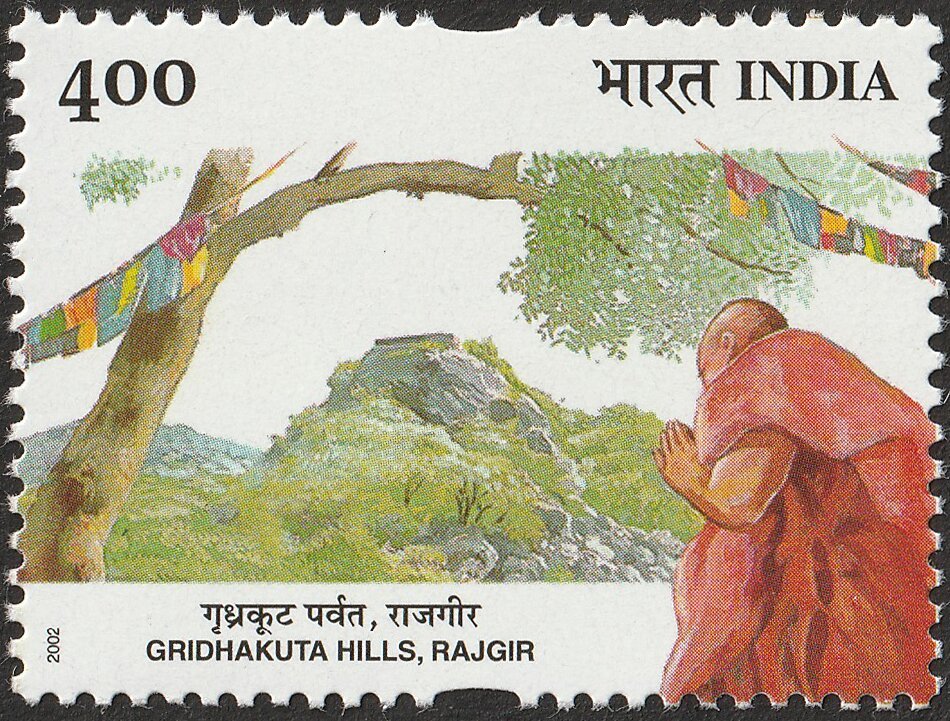Gridhakuta Hills, Rajgir

Technical Data
| Stamp Set | Bauddha Mahotsav Festival |
|---|---|
| Date of Issue | January 22, 2002 |
| Denomination | Rs. 4 |
| Quantity | 1,500,000 |
| Perforation | Syncopated 13½ x 13 |
| Printer | Calcutta Security Printers Ltd |
| Watermark | No Watermark |
| Colors | Multicolor |
| Catalog Codes |
Michel IN 1891 Stamp Number IN 1945 Yvert et Tellier IN 1657 Stanley Gibbons IN 2056 WADP Numbering System - WNS IN003.02 |
| Themes | Festivals | Religion | Temples |
Table of Contents
Commemorative Stamp Set: Gridhakuta Hills, Rajgir
Design Elements:
The stamp design for Gridhakuta Hills prominently features the serene and sacred Vulture’s Peak, nestled among lush greenery and gentle hill slopes. The imagery may include Buddha seated in meditation atop the peak, symbolic of the profound teachings delivered here. Traditional Buddhist symbols, such as the Dharma wheel and prayer flags, add to the spiritual ambiance of the design. The soft golden hues of the sunrise over the hills reflect enlightenment, peace, and wisdom, which are core themes of Buddha’s sermons.
Cultural and Historical Significance:
The Gridhakuta Hills are one of the most revered locations in Buddhist history. As the site where Lord Buddha delivered numerous sermons, including pivotal teachings like the Lotus Sutra, it holds deep spiritual meaning for Buddhists worldwide. Its connection to Rajgir, an ancient city linked with Buddhist, Jain, and Hindu history, makes it an integral part of India’s cultural and religious heritage. The stamp honors both the physical place and the lasting philosophical influence that originated from Buddha’s time there.
Usage:
This commemorative stamp could be used for official correspondence, as well as for special mail related to religious and cultural events, pilgrimages, or government initiatives promoting India’s Buddhist heritage. It would also serve as a collector’s item, cherished by philatelists, history enthusiasts, and followers of Buddhism.
Importance of the Commemorative Stamp Set:
Issuing a stamp set featuring Gridhakuta Hills reflects the significance of preserving and promoting India’s Buddhist legacy. It highlights the importance of Rajgir as a pilgrimage destination and strengthens cultural ties between India and Buddhist-majority countries like Nepal, Japan, Thailand, and Sri Lanka. The stamp also raises awareness about the teachings of Lord Buddha and encourages international tourism to Buddhist sites in India, contributing to the country’s socio-cultural and economic development.
Example of the Stamp Design:
A central image of Buddha meditating on Gridhakuta, with a backdrop of the rolling hills and ancient ruins. The Dharma wheel could be subtly incorporated in the sky, representing Buddha’s teaching of the Noble Eightfold Path. Surrounding elements like stupas or monasteries, along with soft natural colors, could add depth and meaning to the design.
The commemorative stamp set might include:
- Gridhakuta Hills, Rajgir – Symbolizing Buddha’s teachings.
- Mahabodhi Temple, Bodhgaya – Marking the site of Buddha’s enlightenment.
- Dhamek Stupa, Sarnath – Representing the first sermon.
- Mahaparinirvana Temple, Kushinagar – Honoring Buddha’s final journey to nirvana.
Significance:
This stamp set brings attention to India’s invaluable Buddhist heritage and commemorates the sites where Lord Buddha’s teachings flourished. By highlighting the Gridhakuta Hills, it symbolizes the transmission of wisdom and peace that continues to inspire countless individuals across the globe.
